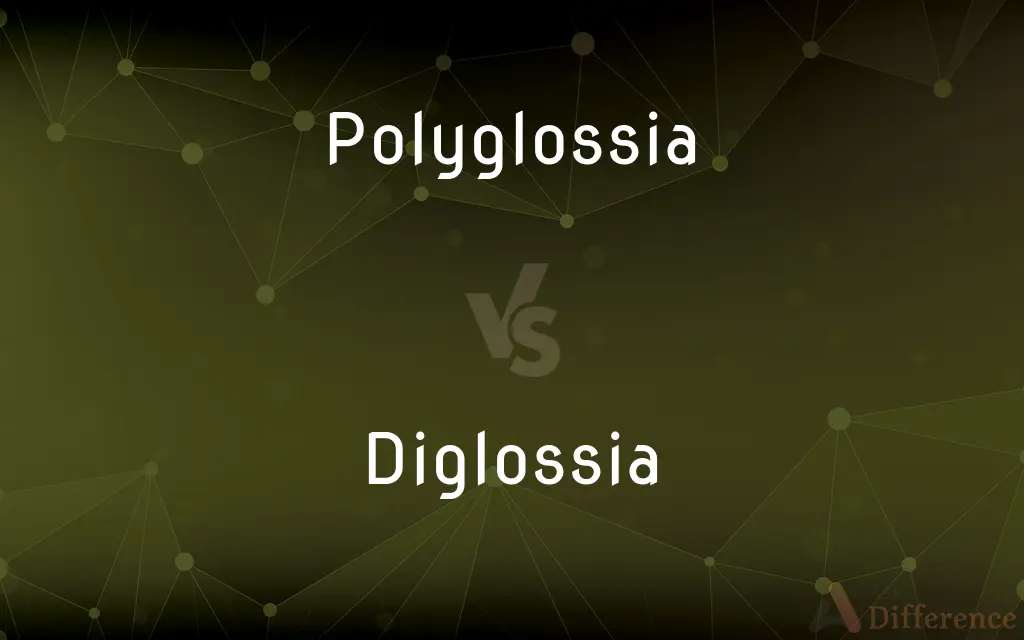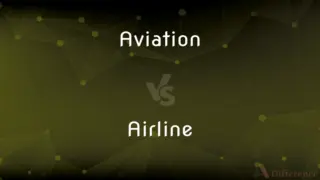Polyglossia vs. Diglossia — What's the Difference?
By Fiza Rafique & Urooj Arif — Updated on March 8, 2024
Polyglossia refers to a social context where multiple languages are used within a community, focusing on diversity. Diglossia, however, emphasizes the use of two languages in different social functions or domains within the same community.

Difference Between Polyglossia and Diglossia
Table of Contents
ADVERTISEMENT
Key Differences
Polyglossia is characterized by a community’s use of several languages, each serving different purposes or catering to different social groups. This linguistic phenomenon supports cultural diversity and facilitates communication in multi-ethnic societies. Whereas diglossia describes a specific bilingualism within a society where two languages have distinct functional distributions; one is used in formal settings, and the other in everyday communication.
The choice of language can be determined by factors such as ethnic identity, social class, or specific situational contexts. This linguistic richness allows individuals to navigate complex social landscapes by switching languages as needed. On the other hand, diglossia involves a clear-cut division between the high (H) variety used in government, media, and education, and the low (L) variety used for informal interactions and within the family.
Polyglossic societies often exhibit a high degree of linguistic tolerance, with languages coexisting without any one language dominating the others. This coexistence encourages a mutual respect among different language speakers. Conversely, in diglossic societies, the H variety may be associated with prestige and power, leading to social stratification based on language proficiency.
The languages in a polyglossic setup may have equal status and legitimacy, allowing for a dynamic interchange among speakers. Whereas, diglossia often results in a hierarchy where the H variety is considered superior or more 'correct' than the L variety, potentially leading to social and linguistic inequality.
Polyglossia promotes multilingualism and the preservation of minority languages, as it values the function of each language within the community. Diglossia, while also promoting bilingualism, can sometimes contribute to the marginalization of the L variety, affecting its development and transmission to future generations.
ADVERTISEMENT
Comparison Chart
Number of Languages
Several languages used
Two languages used
Language Function
Different languages for various purposes
Distinct functions: High (H) and Low (L) varieties
Social Implication
Promotes cultural diversity and tolerance
Can lead to social stratification
Language Status
Languages may have equal status
H variety often seen as superior
Impact on Language Preservation
Supports the preservation of minority languages
May marginalize the L variety
Compare with Definitions
Polyglossia
Polyglossia allows for dynamic language selection based on context.
In New York City, polyglossia is evident in its multicultural neighborhoods.
Diglossia
Diglossia may impact language preservation and development.
Diglossia in Spain promotes both Castilian Spanish and regional languages like Catalan.
Polyglossia
Polyglossia can enhance social cohesion in diverse communities.
Canada’s polyglossic policies aim to respect and preserve its linguistic diversity.
Diglossia
Diglossia involves using two languages for different social functions within a community.
In Haiti, French is used for formal purposes, while Haitian Creole is for informal settings.
Polyglossia
It fosters multilingualism and cultural exchange.
Polyglossia in educational settings encourages students to learn multiple languages.
Diglossia
It distinguishes between high (H) and low (L) language varieties.
Arabic speakers often use Modern Standard Arabic for formal occasions and dialects for everyday conversation.
Polyglossia
It represents a societal acceptance and use of linguistic diversity.
Switzerland’s polyglossic nature promotes four national languages.
Diglossia
Diglossia can contribute to language prestige and social hierarchy.
The use of English in Indian corporate settings exemplifies diglossia.
Polyglossia
Polyglossia refers to the coexistence of multiple languages within a community.
India's diverse linguistic landscape embodies polyglossia.
Diglossia
It reflects a structured linguistic approach to communication.
In Greece, Katharevousa and Demotic Greek historically demonstrated diglossia.
Polyglossia
Polyglossia (pronunciation: /ˌpɒlɪˈɡlɒsɪə/) refers to the coexistence of multiple languages (or distinct varieties of the same language) in one society or area. The term implies a living interaction between multiple languages within a single cultural system, producing significant effects on that culture.
Diglossia
In linguistics, diglossia () is a situation in which two dialects or languages are used (in fairly strict compartmentalization) by a single language community. In addition to the community's everyday or vernacular language variety (labeled "L" or "low" variety), a second, highly codified lect (labeled "H" or "high") is used in certain situations such as literature, formal education, or other specific settings, but not used normally for ordinary conversation.
Polyglossia
The coexistence of multiple languages in the same geographic area.
Diglossia
The use of two markedly different varieties of a language in different social situations, such as a formal variety at work and an informal variety at home.
Diglossia
The coexistence in a given population of two closely related native languages or dialects, one of which is regarded as more prestigious than the other; the similar coexistence of two unrelated languages.
Diglossia
(pathology) The presence of a cleft or doubled tongue.
Common Curiosities
What is diglossia?
Diglossia is a bilingual situation in a society where two languages are used under different conditions: a high variety for formal settings and a low variety for informal ones.
How does polyglossia differ from multilingualism?
Polyglossia is a form of multilingualism specific to a community where several languages are used by its members, while multilingualism can refer to both individual and societal language use.
Can a society be both polyglossic and diglossic?
Yes, a society can exhibit both polyglossia and diglossia if it uses multiple languages for different purposes and also has a clear functional distinction between two of those languages.
What challenges does diglossia present?
Diglossia can present challenges such as linguistic inequality, where speakers of the low variety may face social or economic disadvantages.
What is polyglossia?
Polyglossia is the coexistence of multiple languages within a community, each serving different social functions or groups.
How does diglossia affect language learning?
Diglossia can influence language learning by prioritizing the high variety, potentially leading to undervaluation or neglect of the low variety in educational contexts.
Can diglossia lead to language change?
Yes, the interaction between the high and low varieties in a diglossic situation can lead to linguistic borrowing and influence, potentially changing the languages involved.
How does polyglossia impact social integration?
Polyglossia can facilitate social integration by providing a linguistic platform for diverse cultural expressions and intercultural communication.
Can diglossia contribute to language extinction?
Potentially, if the low variety is significantly undervalued and not transmitted to future generations, it could lead to language shift and eventually extinction.
Is English a high or low variety in any diglossic situations?
English can be either, depending on the context. In some non-English speaking countries, English may serve as a high variety, used in formal education and business.
How does polyglossia benefit a community?
It promotes linguistic diversity, enhances cultural exchange, and supports the preservation of minority languages.
What role does education play in polyglossic and diglossic societies?
Education plays a critical role in both, either by supporting linguistic diversity and multilingual education (polyglossia) or by reinforcing the status of the high variety (diglossia).
Does diglossia always involve a native and a foreign language?
Not necessarily; diglossia can occur with two native languages or dialects where one is designated for formal use and the other for informal contexts.
How do polyglossia and diglossia affect language policy?
They influence language policy decisions, including which languages are taught in schools, used in government, and promoted in society.
How do immigrants contribute to polyglossia?
Immigrants enrich the linguistic landscape by introducing their native languages, contributing to the polyglossic nature of a community.
Share Your Discovery

Previous Comparison
Aviation vs. Airline
Next Comparison
Camel vs. BeigeAuthor Spotlight
Written by
Fiza RafiqueFiza Rafique is a skilled content writer at AskDifference.com, where she meticulously refines and enhances written pieces. Drawing from her vast editorial expertise, Fiza ensures clarity, accuracy, and precision in every article. Passionate about language, she continually seeks to elevate the quality of content for readers worldwide.
Co-written by
Urooj ArifUrooj is a skilled content writer at Ask Difference, known for her exceptional ability to simplify complex topics into engaging and informative content. With a passion for research and a flair for clear, concise writing, she consistently delivers articles that resonate with our diverse audience.
















































